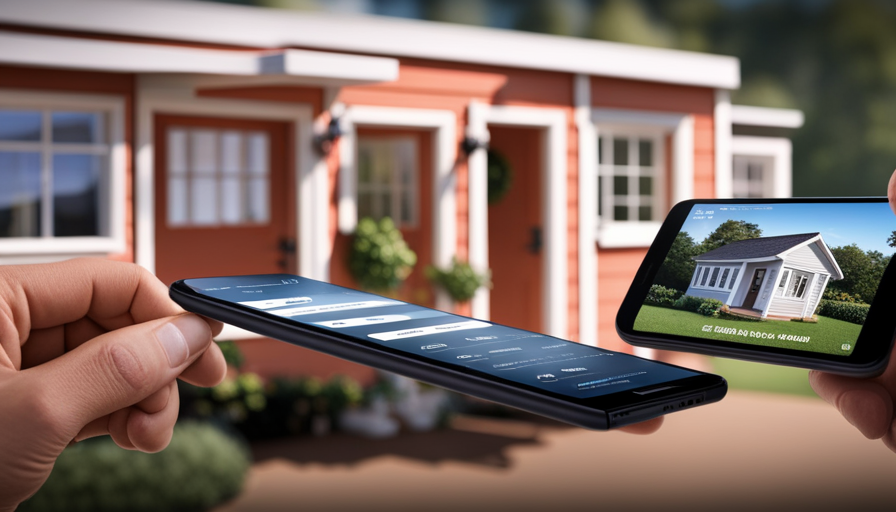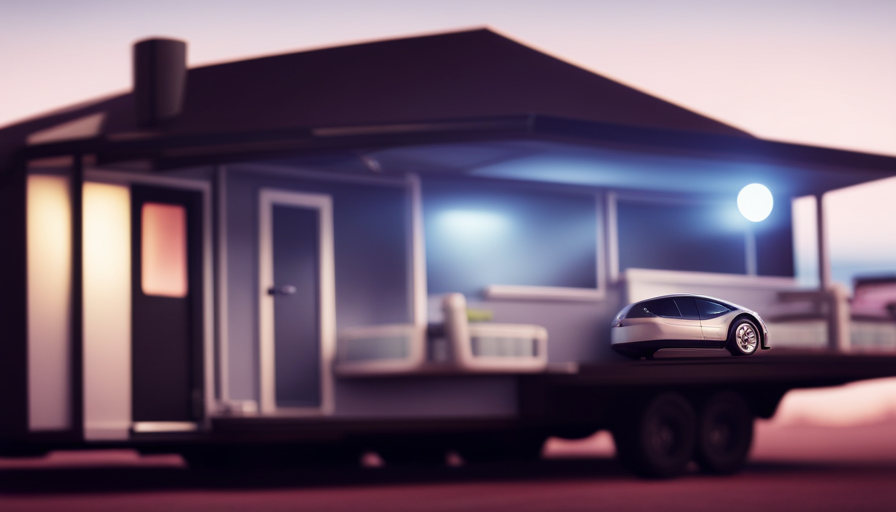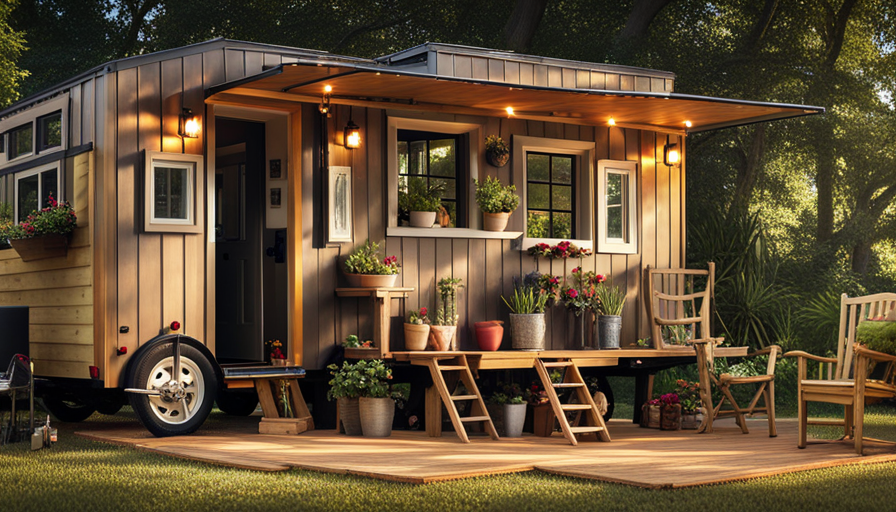Picture this: an active community of small home enthusiasts, united and thriving due to the convenient capabilities of a mobile app.
Imagine a virtual space where like-minded individuals come together to share their passion for minimalistic living, exchange design ideas, and find valuable resources.
With just a few taps on your smartphone, you can access a world of inspiration, connect with experts in the industry, and even streamline the buying and selling process of tiny houses.
This mobile app revolutionizes the tiny house industry, providing a platform for networking, organizing events, and staying informed about legal and zoning regulations.
It’s a one-stop-shop for all things tiny house-related, allowing you to plan and organize events, access valuable tips and information, and get inspired by success stories and testimonials.
The possibilities are endless when a mobile app meets the tiny house movement.
Welcome to the future of minimalistic living.
Key Takeaways
- Connect with like-minded individuals and build a community of tiny house enthusiasts
- Access valuable resources and information about legal and zoning regulations, financing options, and eco-friendly materials
- Streamline the buying and selling process by browsing listings, connecting with potential buyers or sellers, and facilitating negotiations and transactions
- Inspire and ignite creativity by showcasing inspiring tiny house designs, success stories, and testimonials, providing valuable insights and inspiration for own projects.
Connect with Like-Minded Individuals
If you’re looking to connect with like-minded individuals in the tiny house community, our mobile app provides a platform where you can easily find and engage with others who share your passion for minimalist living and sustainable housing solutions.
With our app, you can discover local meetups and events where you can meet fellow enthusiasts and exchange ideas. Additionally, our app allows you to join online communities dedicated to the tiny house movement, where you can connect with people from all over the world who are interested in the same lifestyle. These communities are a great place to ask questions, seek advice, and share your own experiences.
By connecting with like-minded individuals through our app, you can expand your network and find inspiration for your own tiny house journey.
In the next section, we’ll explore how our app can help you find design and construction resources to bring your dream tiny house to life.
Find Design and Construction Resources
When you’re searching for design and construction resources, you might think it’s difficult to find the right information. But with this app, you’ll have access to a wide range of reliable sources that make your journey easier and more enjoyable.
Explore innovative building materials with our curated list of suppliers, providing you with options you may never have considered.
Discover unique design ideas from experienced architects and homeowners who’ve transformed tiny spaces into stunning works of art.
Stay up-to-date with the latest trends and techniques in the tiny house industry through our regularly updated articles and videos.
With this app, you’ll have all the resources you need to create your dream tiny house.
Now, let’s move on to how this app can streamline the buying and selling process.
Streamline the Buying and Selling Process
When it comes to streamlining the buying and selling process in the tiny house industry, there are several key points to consider.
First, our app allows users to easily browse listings of tiny homes for sale, providing a comprehensive database of available options.
Second, it enables users to connect with potential buyers or sellers, facilitating communication and negotiation.
Lastly, our app simplifies the negotiation and transaction process, making it easier for both parties to come to an agreement and complete the sale.
Browse Listings of Tiny Homes for Sale
As you scroll through the mobile app, you’ll find a wide variety of adorable tiny homes for sale that will make your heart skip a beat. The app allows you to browse listings of tiny homes from different builders across the country, giving you access to a vast selection of options.
Whether you’re looking for a rustic cabin in the woods or a modern eco-friendly design, this app has it all. Not only can you connect with tiny house builders directly through the app, but you can also explore financing options to make your dream of owning a tiny home a reality.
With just a few taps, you can browse through detailed listings, view high-quality photos, and even schedule a tour. This seamless browsing experience sets the stage for the next section, where you can connect with potential buyers or sellers and take the next step in your tiny house journey.
Connect with Potential Buyers or Sellers
To truly immerse yourself in the world of tiny homes, you can connect with potential buyers or sellers through the app, taking the next step towards your dream of owning a cozy and sustainable living space. Here are four ways the app can help you in this process:
-
Find Financing Options: The app provides access to a variety of financing options specifically tailored for tiny homes. From traditional mortgages to specialized loans, you can explore and compare different offers to find the best fit for your budget.
-
Browse Eco-Friendly Materials: Building or renovating a tiny home often involves using environmentally friendly materials. The app allows you to explore a wide range of sustainable options, from reclaimed wood to energy-efficient appliances, ensuring that your tiny home is both stylish and environmentally conscious.
-
Connect with Like-Minded Individuals: The app creates a community of tiny home enthusiasts, where you can connect with like-minded individuals who are also looking to buy or sell. Share ideas, ask for advice, and learn from others’ experiences in the tiny house movement.
-
Facilitate the Negotiation and Transaction Process: Once you find a potential buyer or seller, the app streamlines the negotiation and transaction process, providing a secure platform for communication and documentation. From initial offers to final contracts, the app ensures a smooth and efficient experience.
By connecting with potential buyers or sellers through the app, you can explore financing options and eco-friendly materials while being part of a community. This sets the stage for the subsequent section on how the app can facilitate the negotiation and transaction process.
Facilitate the Negotiation and Transaction Process
Make negotiating and finalizing the purchase or sale of your dream tiny home a breeze with the app’s intuitive tools and secure platform. Our mobile app offers a range of features designed to streamline the negotiation and transaction process.
With built-in negotiation tools, you can easily communicate with potential buyers or sellers, discussing pricing, terms, and any other details. The app also provides a secure platform for sharing and signing legal documents, ensuring a smooth and efficient transaction.
Additionally, you can track the progress of the negotiation and transaction through real-time updates and notifications. Access valuable tips and information to guide you through the process, from finding the right financing options to understanding legal requirements.
Our app is your all-in-one solution for successfully navigating the world of tiny house buying and selling.
Access Valuable Tips and Information
Discover the essential tips and valuable information you need to know about the tiny house industry with just a tap of your finger on our mobile app. Our app is designed to provide you with all the knowledge you need to navigate the world of tiny houses.
Here are three ways our app can help you:
-
Find community: Connect with other tiny house enthusiasts and learn from their experiences. Our app allows you to join forums, participate in discussions, and even arrange meetups with like-minded individuals.
-
Discover eco-friendly options: Learn about sustainable materials, energy-efficient appliances, and green building practices. Our app provides resources and guides to help you make environmentally conscious choices.
-
Get expert advice: Access a wealth of information from industry experts, including architects, builders, and interior designers. From design tips to construction techniques, our app has it all.
With our mobile app, you can find the community, discover eco-friendly options, and get expert advice you need to make your tiny house dream a reality.
And next, we’ll show you how to plan and organize tiny house events.
Plan and Organize Tiny House Events
One of the key aspects of the thriving tiny house community is the ability to plan and organize exciting events for enthusiasts to come together and share their passion. With the help of a mobile app, this process becomes even more streamlined and efficient. The app can offer features like collaborative workshops, where users can brainstorm and share ideas for building and designing their tiny houses.
Additionally, the app can host tiny house design competitions, allowing users to showcase their creativity and potentially win prizes. These events not only bring the community closer together but also provide valuable opportunities for learning and growth. By participating in these events, enthusiasts can gain inspiration and knowledge to further enhance their own tiny house projects.
Now, let’s dive into how the app can help users stay informed about legal and zoning regulations.
Stay Informed about Legal and Zoning Regulations
Navigating the legal and zoning regulations in the tiny house world can be like trying to find a needle in a haystack, but with the app’s comprehensive database and real-time updates, users can stay in the loop effortlessly. Here are some ways the app keeps you informed about legal and zoning regulations:
-
Explore Financing Options: The app provides valuable information on financing options for tiny house enthusiasts. From loans to grants, users can easily access resources and explore the best options for their unique needs.
-
Explore Innovative Tiny House Designs: Stay up-to-date with the latest trends and innovative designs in the tiny house industry. The app features a gallery of inspiring tiny house designs, allowing users to explore and gather ideas for their own projects.
-
Real-Time Updates: The app ensures users are always aware of any changes or updates to legal and zoning regulations. This feature eliminates the need to constantly search for information, saving time and effort.
Now, let’s get inspired by success stories and testimonials and see how others have made their tiny house dreams a reality.
Get Inspired by Success Stories and Testimonials
Immerse yourself in the extraordinary journeys of others who’ve turned their dreams into reality. Their inspiring success stories and heartfelt testimonials will ignite a fire within you to create your own tiny haven.
Hearing success stories from people who’ve successfully built and lived in tiny houses can provide valuable insights and inspiration for your own project. Through a mobile app, you can gain access to a wealth of success stories and testimonials from individuals who’ve experienced the joys and challenges of tiny house living.
These stories can give you a glimpse into the possibilities and potential pitfalls of the tiny house lifestyle, helping you make informed decisions and avoid common mistakes. By learning from others’ experiences, you can navigate the tiny house journey with confidence and create a home that perfectly suits your needs and aspirations.
Frequently Asked Questions
How can a mobile app help me connect with like-minded individuals in the tiny house industry?
A mobile app can revolutionize how I connect with like-minded individuals in the tiny house industry. By using the app, I can easily find and connect with professionals who share my passion for tiny homes.
It provides a platform where I can network, exchange ideas, and learn from their experiences. Additionally, the app offers a plethora of inspiration, showcasing innovative designs and creative ideas to fuel my own tiny house projects.
It’s a tech-savvy solution that brings the tiny house community together, fostering collaboration and growth.
Where can I find design and construction resources through a mobile app?
I can find design inspiration and construction tutorials through a mobile app. The app provides a wide range of resources for those interested in the tiny house industry.
From design ideas to step-by-step construction guides, it’s a one-stop-shop for all my needs.
The design inspiration section showcases innovative and stylish tiny house designs, while the construction tutorials offer detailed instructions and tips for building my own tiny house.
This mobile app is a valuable tool for anyone looking to get started in the tiny house industry.
How does a mobile app streamline the buying and selling process in the tiny house industry?
Using a mobile app to streamline the buying and selling process in the tiny house industry is like having a digital assistant that takes care of all the details.
Transactions are made faster and more efficient, with real-time updates on listings, offers, and negotiations.
The app improves communication between buyers and sellers, allowing for instant messaging and video calls.
It’s like having a personal concierge guiding you through the entire process, making it easier and more convenient than ever before.
What valuable tips and information can I access through a mobile app related to tiny houses?
Through a mobile app, I can access valuable tips and information about tiny houses.
Stay up-to-date with the latest tiny house design trends, ensuring my tiny home is stylish and functional.
Additionally, the app provides me with financing options for tiny houses, making it easier to navigate the financial aspects of building or purchasing a tiny home.
With this app, I have all the information I need to make informed decisions about my tiny house journey.
Can a mobile app help me plan and organize tiny house events, and if so, how?
Sure, a mobile app can definitely help you plan and organize tiny house events. It’s ironic how a tiny house, which is all about simplicity and minimalism, can benefit from a tech-savvy solution.
With a mobile app, you can easily create event schedules, send invitations, track RSVPs, and even manage ticket sales. Plus, you can use push notifications to keep attendees updated in real-time.
It’s like having a personal event planner right in your pocket.
Conclusion
In conclusion, the mobile app revolutionizes the tiny house industry, offering a world of possibilities at our fingertips. The app provides a one-stop solution for all our tiny house needs. It’s like having a toolbox of knowledge and inspiration in our pocket, ready to help us navigate the world of tiny living.
With the ability to connect with like-minded individuals, access valuable resources, and streamline the buying and selling process, the app offers convenience and efficiency.
So why wait? Download the app and unlock the door to your tiny house dreams today!
Hi, I’m Emma. I’m the Editor in Chief of Tiny House 43, a blog all about tiny houses. While tree houses are often associated with childhood, they can be the perfect adult retreat. They offer a cozy space to relax and unwind, surrounded by nature. And since they’re typically built on stilts or raised platforms, they offer stunning views that traditional homes simply can’t match. If you’re looking for a unique and romantic getaway, a tree house tiny house might just be the perfect option.
















